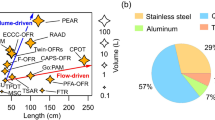Abstract.
The relative importance of the three particulate matter (PM) size fractions in ambient air, i.e. coarse (2.5–10 µm), fine (0.1–2.5 µm) and ultrafine (<0.1 µm) fractions, on the induction of adverse health effects is still unknown. Moreover, there is no straightforward relationship between ambient concentration levels, exposure (external dose) and the dose delivered to the target site (internal dose). Recently, a human and a rat airway PM deposition model (MPPDep V1.1) have been developed by CIIT Centers for Health Research and the National Institute of Public Health and the Environment (RIVM), based on the work of O.G. Raabe et al. (1977, In: W.H. Walton, editor, Inhaled Particles IV/2; Pergamon, Oxford) and S. Anjilvel and B. Asgharian (1995, Fundam Appl Toxicol 28:41–50). This paper describes studies using cadmium chloride (CdCl2) as a model for toxic aerosol particles to (1) investigate the role of particle size in the development of pulmonary effects, and (2) evaluate the MPPDep model, by comparing predicted deposition with measured deposition of CdCl2 in the respiratory tract. Rats (ten per group) were exposed for a single 4-h period to CdCl2 particles at various sizes, i.e. 33, 170, 637 and 1495 nm, all at a target concentration of 1 mg/m3. Immediately after exposure, four of ten rats per group were killed and trachea, lung lobes, heart, liver and kidneys were collected and preserved to determine the amount of CdCl2 present in each of these organs. CdCl2-induced toxicity, as measured by lactate dehydrogenase (LDH), N-acetyl glucosaminidase (NAG) and protein levels in bronchoalveolar lavage fluid, was determined in the remaining six rats per group the day after exposure. Animals exposed to 33 nm particles showed the highest level of respiratory toxicity, followed by animals exposed to 637 nm particles, then to 170 nm particles and finally by those exposed to 1495 nm particles. Pulmonary cadmium levels showed a similar relationship. The results from the present study suggest that the induction of pulmonary toxicity following inhalation exposure to soluble CdCl2 particles in the range 30–1500 nm depends on the amount of deposited material, which in its turn depends on the initial (aerodynamic) particle size. In addition, the MPPDep model accurately predicted the measured CdCl2 deposition. Conclusively, for soluble particles the deposited pulmonary mass (dose) of particles is important for toxicity and is dependent of particle size. These findings may have serious impact on the evaluation of the role of various particle sizes in PM10-associated health effects.
Similar content being viewed by others
Author information
Authors and Affiliations
Additional information
Electronic Publication
Rights and permissions
About this article
Cite this article
Cassee, F.R., Muijser, H., Duistermaat, E. et al. Particle size-dependent total mass deposition in lungs determines inhalation toxicity of cadmium chloride aerosols in rats. Application of a multiple path dosimetry model. Arch Toxicol 76, 277–286 (2002). https://doi.org/10.1007/s00204-002-0344-8
Received:
Accepted:
Issue Date:
DOI: https://doi.org/10.1007/s00204-002-0344-8




